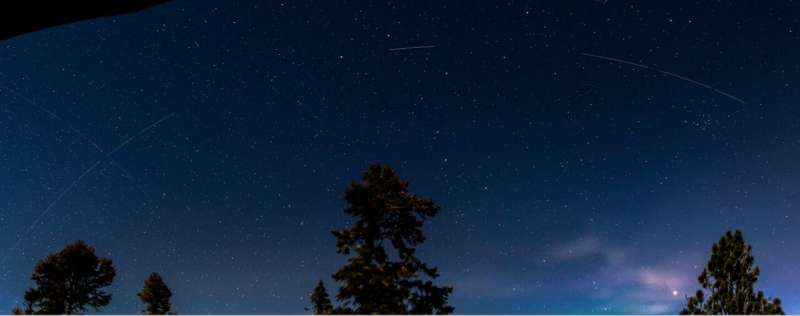This article has been reviewed according to Science X's editorial process and policies. Editors have highlighted the following attributes while ensuring the content's credibility:
fact-checked
peer-reviewed publication
trusted source
proofread
Study quantifies satellite brightness, challenges ground-based astronomy

The ability to have access to the Internet or use a mobile phone anywhere in the world is taken more and more for granted, but the brightness of Internet and telecommunications satellites that enable global communications networks could pose problems for ground-based astronomy. University of Illinois Urbana-Champaign aerospace engineer Siegfried Eggl coordinated an international study confirming recently deployed satellites are as bright as stars seen by the unaided eye.
"From our observations, we learned that AST Space Mobile's BlueWalker 3—a constellation prototype satellite featuring a roughly 700 square-foot phased-array antenna—reached a peak brightness of magnitude 0.4, making it one of the brightest objects in the night sky," Eggl said. "Although this is record breaking, the satellite itself is not our only concern. The untracked Launch Vehicle Adapter had an apparent visual magnitude of 5.5, which is also brighter than the International Astronomical Union recommendation of magnitude 7."
For comparison, the brightness of the stars we can see with an unaided eye is between minus 1 and 6 magnitude, minus 1 being the brightest. Sirius, the brightest star, is minus 1. Planets like Venus can sometimes be a bit brighter—closer to minus 4, but the faintest stars we can see are roughly magnitude 6.
Watch a video showing a starry sky with three satellites: BlueWalker 3 at 19:52:45, 19:52:56, 19:53:18, 19:53:29; Starlink-4781 is visible at 19:52:54 and 19:53:26, leading BlueWalker 3; Starlink-4016 is parallel and slightly behind BlueWalker 3 at 19:53:34. Video courtesy: Marco Langbroek, Delft Technical University.
"One might think if there are bright stars, a few more bright satellites won't make a difference. But several companies plan to launch constellations," Eggl said. "For example, Starlink already has permission to launch thousands of satellites, but they'll probably get their full request of tens of thousands granted eventually.
"And that's just one constellation of satellites. Europe and China want their own constellations and so does Russia. Just those in the United States being negotiated with the FCC amount to 400,000 satellites being launched in the near future. There are only 1,000 stars you can see with the unaided eye. Adding 400,000 bright satellites that move could completely change the night sky."
Eggl is a member of the International Astronomical Union Centre for the Protection of the Dark and Quiet Sky from Satellite Constellation Interference, IAU.
"BlueWalker 3 is so bright that most of the big telescopes such as the Rubin Observatory believe it could obliterate large parts of exposures," Eggl said. "They already have to avoid observing Mars and Venus for the same reason, but we know where the planets are so we can dodge them. We cannot accurately predict where all the satellites will be years in advance. Just accepting recurring data loss in multi-billion-dollar observatories is not an option either."
He said although satellites won't necessarily damage the telescope's CCDs, or charge-coupled devices, they will still cause data loss from the streaks. Extremely bright satellites could ruin the entire field of view, like trying to stargaze when someone periodically shines a flashlight into your eyes.
Eggl said several solutions to the problem are being explored in collaboration with the Laboratory for Advanced Space Systems at Illinois and satellite operators such as SpaceX.
"Starlink is looking at making their satellites' surfaces darker, which absorbs more and reflects less visible sunlight. But the absorption generates heat. The satellites then have to emit infrared light which means observations in optical wavelengths don't have as large of a problem, but infrared observations might. And heat is one of the biggest engineering problems that we have in space. So, painting everything black comes with repercussions," he said.
Another idea from SpaceX is to make satellites' solar panels more reflective with dielectric mirrors. The mirrors allow the satellites to change the direction of the reflection so that it's not pointing directly at the Earth.
"If SpaceX can make the solar panels point in a different direction to avoid glints, or use these mirror tricks, they might solve a lot of the problems we have with the optical flaring of Starlink satellites," Eggl said. "With other providers, it's not quite as easy. AST has gigantic satellites, with hundreds of square feet of electronic phased arrays, that they need to communicate with cell phones on the ground. If they made satellites smaller more of their radio signals would leak out through so-called 'side lobes' potentially affecting radio astronomy sites.
Eggl said AST also prefers to keep the satellite pointed toward the surface of the Earth to achieve maximum efficiency. Starlink solutions may not easily translate to AST satellites and new mitigation strategies are needed.
"We are trying to work with the space industry, where possible," he said. "We want to solve this together so it's a collaborative effort that everybody can sign onto because that's the fastest route to get things done."
The study, "Optical observations of an ultrabright constellation satellite," was written by Sangeetha Nandakumar, Siegfried Eggl, Jeremy Tregloan-Reed, et al. It is published in the journal Nature. DOI:10.1038/s41586-023-06672-7
Ph.D. student Nandakumar analyzed the data for this first international study to be published from the center. Nandakumar works with Jeremy Tregloan-Reed at the Universidad de Atacama in Chile.
More information: Sangeetha Nandakumar et al, The high optical brightness of the BlueWalker 3 satellite, Nature (2023). DOI: 10.1038/s41586-023-06672-7
Journal information: Nature





















